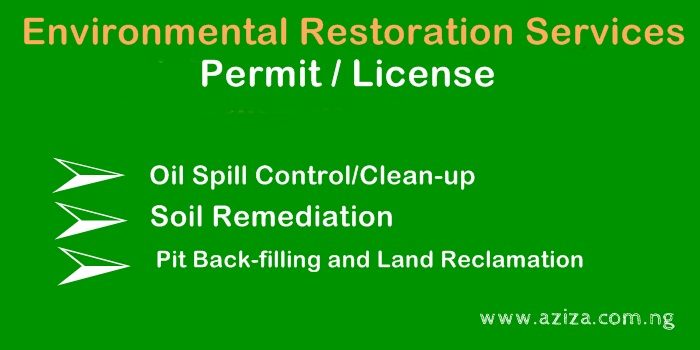Environmental Restoration Services permit/ license or popularly called Oil Spill Control/Clean-up or Remediation permit. They are the same permit/ license in Nigeria.
In Nigeria, Environmental Restoration Services includes Remediation and Restoration services. There are requirements for one/firm to perform these services. One of the requirements is to obtain an Environmental Restoration Services Permit or license which covers Oil Spill Control/ Clean-up and Soil Remediation from Department of Petroleum Resources (DPR) Permit.
We also explained the process of obtain Environmental Restoration Services Permit/ License from Department of Petroleum Resources (DPR) in Nigeria.
Read: Waste Management Services DPR Permit / License
There are 3 Services under Environmental Restoration Permit/ License
They are:
1. Oil Spill Control/Clean-up
2. Pit Back-filling and Land Reclamation
3. Soil Remediation
Environmental Restoration Services DPR (OGISP) Permit Requirement
- *Certificate of incorporation
- *Certified true copy of memorandum & articles of assoc.
- *Certified true copy of form c.07/cac2.3/cac 7
- *Current tax clearance certificate
- Company’s profile
- Comprehensive staff list & curriculum vitae of key staff (should include position & qualification of staff)
- List of equipment/facility available to the company
- List of approved expatriate quota position & their Nigerian understudies
- Proposed training programme for Nigerian staff for the current year
- Registration by relevant professional body
- Technical agreement or MOU with Nigerian company/DPR accredited laboratory (where applicable)
- *employee’s compensation scheme (Nigeria Social Insurance Trust Fund (NSITF))
- Health, Safety, Environment and Community (HSEC)
- Current medical retainership agreement with a hospital or clinic located in company’s operational location
Read: Business License And Permits In Nigeria
Environmental Restoration Services Permit / License Processes
- Have an Account with DPR
- Apply Environmental Restoration Services
- Choose Oil Spill Control/ Clean-up Services or
- Choose Pit Back-filling and Land Reclamation Services or
- Choose Soil Remediation service
- Generate RRR number for the permit
- Make Permit payment (Oniline or Direct Bank Deposit)
- Supply Company details
- Upload statutory documents
- Prepare & Make presentation
- Receive your Waste Management Services DPR Permit
Permit / License Cost
FEE ₦257,500.00
Environmental Restoration is closely allied with Ecological Restoration or Environmental Remediation is the term used more in the realms of industry, public policy, and the civil services. Environmental restoration is a method to renew a damaged environment. A process in which a damaged resource is renewed. Biologically. Structurally. Functionally.”
Read: Local Content Registrations: NOGIC JQS and NCEC
Environmental Remediation refers to reducing radiation exposure in an environment such as contaminated soil, groundwater or surface water. The purpose is more than just eliminating radiation sources; it is about protecting people and the environment against potential harmful effects from exposure to ionizing radiation.
Remediation and Restoration describe actions that return natural areas to healthy communities for fish, wildlife, and people. So what is the difference between remediation and restoration?
The difference between Environmental Remediation and Restoration
Environmental Remediation.
Remediation is the process of stopping or reducing pollution that is threatening the health of people or wildlife.
Environmental Remediation refers to reducing radiation exposure, for example, from contaminated soil, groundwater or surface water. The purpose is more than just eliminating radiation sources; it is about protecting people and the environment against potential harmful effects from exposure to ionizing radiation.
Environmental Remediation is the only way to clean up the contaminants in soils and groundwater. General technical methodologies include transfer of contaminants solely by themselves, with contaminated soils, or groundwater to other places for final treatment or disposal; confinement of contaminants in place; and destruction of contaminants in place.
Environmental Restoration
Once the harmful contamination causing pollutants are removed or contained in an environment, the next step is to restore the habitat environment.
Remediation is the only way to clean up the contaminants in soils and groundwater. General technical
Read: Oil & Gas Operation Permits & Certificates Nigeria
Restoration is the enhancement, creation, or re-creation of habitats, those places where fish and wildlife live. During this phase, construction projects are often undertaken to return the environment to a healthy functioning ecosystem.
Remediation controls the pollution, while restoration efforts, like the construction of wetlands and the planting of trees and vegetation, complete the process of providing healthy habitat for fish and wildlife, and ensuring safe environments for people to live and work in.
Remediation and restoration are most effective when they are done together in a coordinated effort.

